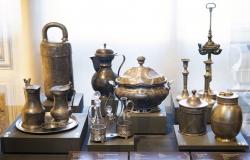Where was Plato buried? In the Athenian Academy, in the garden reserved for him (a private area intended for the Platonic school) near what they called the Museion or sacellum sacred to the Muses. This is not the only news that emerges from the highly sophisticated deciphering of some of the Herculaneum papyri. This was revealed by papyrologist Graziano Ranocchia of the University of Pisa, at the conclusion of the first phase of the five-year «GreekSchools» research project conducted together with the National Research Council, presented at the National Library of Naples. Not only. The papyri (they are those of Philodemus of Gadara, preserved in the Villa dei Pisoni of Herculaneum), also reveal new circumstances surrounding Plato’s death and his last night.
How was this possible? Acquiring approximately 30% more text of the work of Philodemus of Gadara compared to the previous edition of 1991. Without counting the discovery of 10 new medium-sized papyrus fragments. Already several years ago some Greek words in the Herculaneum Papyri had been deciphered using the phase contrast X-ray tomography technique, which had made it possible to distinguish some letters of the Greek alphabet on the documents thanks to the difference in thickness given by the ink. But the secret weapon of three students was an artificial intelligence algorithm which with the help of X-ray scanning made it possible to decipher 2 thousand Greek letters taken from a carbonized papyrus found in Herculaneum, burned during the eruption of Vesuvius in 79 AD
So far, in fact, only 5% of one papyrus of the four scanned has been deciphered, all precious material for shedding light on many still unknown aspects of daily life in ancient Rome and Greek culture. During the 18th century excavations of Pompeii and Herculaneum, more than a thousand papyrus rolls were recovered from the luxurious residence, believed to be the property of Julius Caesar’s father-in-law. Today the inventory exceeds 1800 pieces, including whole or partially preserved rollsperhaps broken into several parts over time, unfolded papyri whose different portions are sometimes recorded with different numbers, and even scrolls no longer existing in place.
There’s another gem. The open scrolls (around 400) have returned Greek texts that did not come down to us through the medieval manuscript tradition: first of all the key work of Epicurus «On nature», the corpus of works by Philodemus of Gadara, to whom we owe the formation of the library of Herculaneum, of other Epicurean philosophers such as Demetrius Lacone, Polystratus, Carneiscus, Colotes and Metrodorus both of Lampsacus, and of the stoic Chrysippus. There are few works in Latin, of a more varied nature due to the presence of comedies, historiographical works, political and legal texts. Friend of the major poets of the Augustan age and author of elegant epigrams, Philodemus favored the spread of the Epicurean doctrine in Roman society with his teaching. Furthermore, the «Collection of philosophers» by Philodemus of Gadara (75-50 BC), the only reference for subsequent studies in the history of philosophy, will be published in an electronic edition open access on a pioneering open-source web platform.






